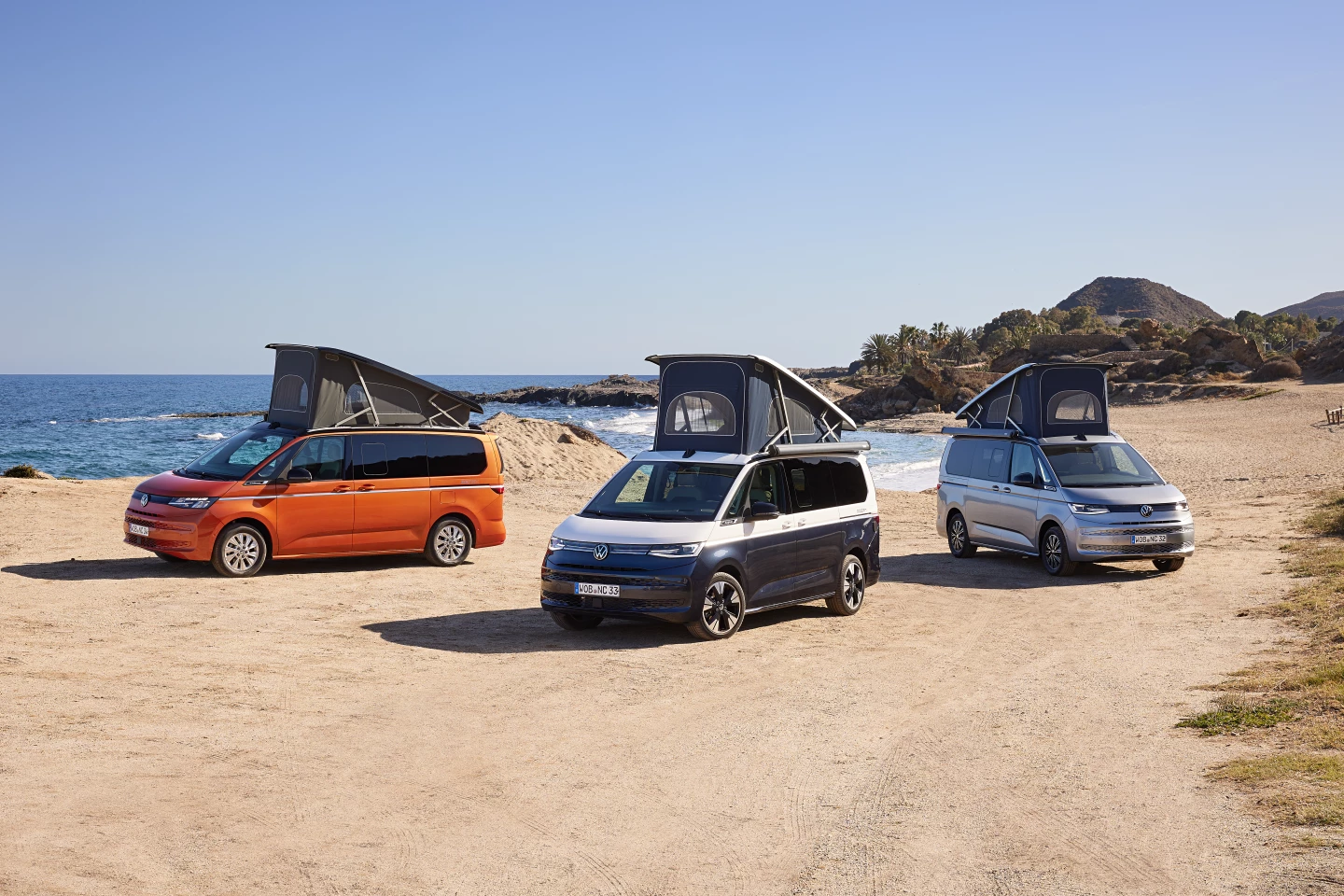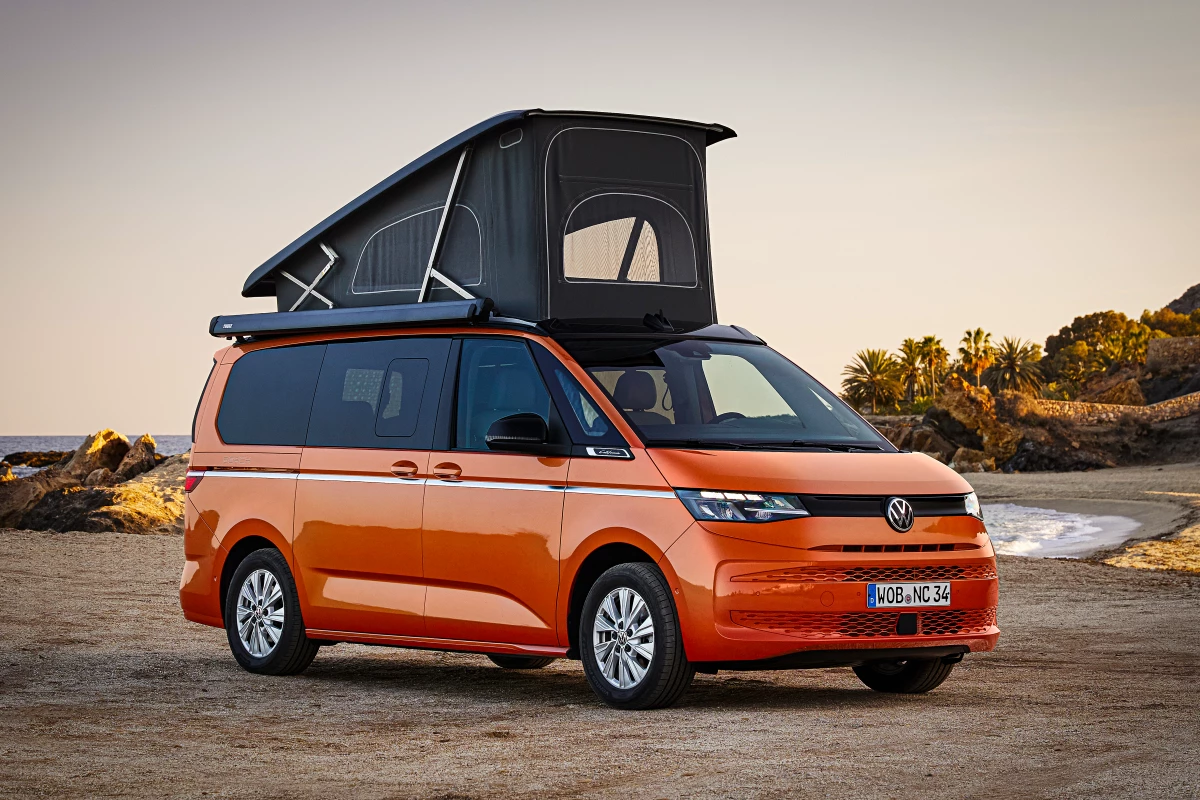No matter how many amazing camper vans other brands come out with, there's still only one Volkswagen California... and it just got a dramatic makeover, from tires to pop-up roof.
The all-new T7 California breaks out of its mini-camper shell as a slightly larger, roomier camper that pushes VW van life into the next generation. Two sliding entries, dual sunshades and new outdoor kitchen equipment invite campers to spend less time scrolling their phones inside van walls and more time immersing themselves in the great outdoors around them. Throw in the California's first-ever combination of plug-in hybrid powertrain and 4Motion all-wheel drive, and this might be Volkswagen's most impressive California ever.An all-new eco-friendly, all-terrain platform for adventure
Just as Volkswagen said it would, the all-new California has left its long-term Transporter foundation for the loving arms of the versatile Multivan MPV. That's part of a broader commercial vehicles strategy through which VW has teamed with Ford on more basic panel vans, but the big takeaway is that the California starts from an even sweeter base vehicle, a passenger van complete with floor rail modularity, MQB platform-based driver assistance systems, and three different powertrain options.

Chief among the powertrains is the plug-in eHybrid that enables Volkswagen to go head to head with its partner-cum-rival Ford in terms of eco-friendly small camper vans that offer zero tailpipe emissions in town and plenty of range beyond town. VW's PHEV powertrain has 5 fewer miles (8 km) of all-electric driving than Ford's, for an estimated 30 (50 km), but gains a welcome new addition: 4Motion all-wheel-drive.
In fact, the California becomes the very first member of the new MQB family to get a 4Motion option. So the already attractive 241-hp PHEV gets even more desirable, putting more traction to the ground in the type of slippery off-road and all-season conditions in which a camper van will inevitably find itself.
No more mini

It's worth noting that Volkswagen leaps right over the standard-wheelbase Multivan to build the new California atop a long-wheelbase model with a total length of 517 cm (204 in). That takes the "mini" right out of the new camper, rising above the 5-m (16.4-ft) cutoff we use to define the mini-camper category. Buyers shouldn't mind, though, as they'll enjoy a little extra length and space.
Unfortunately, those extra inches have not proved enough incentive for VW to carve out a California bathroom, a feature sorely missed by many owners and would-bes. The new California still lacks this everyday necessity, leaving buyers to make their own arrangements or upsize to a Grand California for such conveniences.
The complete California experience, reworked
Volkswagen certainly doesn't let the extra size go to waste, though, putting it to work on several subtle but practical changes. First, it slides the kitchen block rearward, just as it did in the California Concept, to better utilize the driver-side sliding rear door, a new feature for full-blown California campers with kitchens.
Not only does the rear kitchen position open up clear entry and exit for the driver-side rear passenger, it creates more space and comfort for anyone sitting on the swiveled driver seat at camp. It also gives larger drivers more space to adjust the seat backwards.
The set-back kitchen also clears space for Volkswagen to swing the fridge/freezer over to the front end of the console, providing convenient access from inside and out. Not only did the California 6.1 lack this feature before, but campers based on mid-size vans in general tend to lack it, due to the absence of a driver-side rear door and sufficient space behind the driver's seat.

Volkswagen cuts out the indoor/outdoor cooking flexibility it showed on the California Concept by eliminating the portable stove and open induction cooktop. The high position and one-directional hinged lid on the gas stove impede use from outside the van, so campers will have to cook inside. With that said, those who want to cook outside can simply bring along a portable camping stove of their own and use it on the multi-positional worktop that mounts to the outer wall of the kitchen when it's not being used over top the fridge as a counter extension.
Volkswagen further capitalizes on the T7 Multivan's dual sliding doors to create what it calls a three-zone layout, encouraging van lifers to spend time outdoors. The first zone is the van interior itself, while the other two are the spaces immediately outside each sliding door. Buyers can choose to install the available pull-out awning on either the left or right side, using a sunshade or the like on the opposite side, as shown below.

VW imagines the driver's side being used for meal prep and dining, given its location near the kitchen, and the passenger side more as an open-air lounge for playing games, reading a book, or simply relaxing and taking in the views – a camp couch seems in order for the latter space.
As for the interior, Volkswagen replaces the two-seat rear bench with two individual rear seats mounted to the floor rails. Each 24-kg (53-lb) seat can then remove independently, adding flexibility for managing cargo and passengers. At night, the two seats fold flat to support the 198 x 106-cm (78 x 42-in) foldaway mattress.

The 205 x 114-cm (81 x 45-in) bed in the pop-up roof finishes off the four-berth camping layout. The pop-top area loses the oversized panoramic mesh featured on last year's concept but still has a window on each of the three fabric walls.
Volkswagen has been working to make its vans more smart home-like, dating back to the integrated control touchscreen in the Grand California. The California 6.1 got an overhead landscape touchscreen in the cockpit headliner, and the new T7 California gets a more neatly integrated tablet-style command screen in the passenger-side C-pillar.

Campers can use the touchscreen to adjust the lighting, refrigerator temperature and auxiliary camp heater or check camper vitals like the 80-Ah lithium leisure battery charge and water tank levels. An accompanying app provides access to the system via mobile devices and the driver's infotainment screen.
Additionally, VW integrates a handy feature into the myriad light switches around the van interior, allowing users to double-tap them to shut off all interior lighting at once – certainly more convenient than crawling to the touchscreen or rummaging around for a smartphone.
Ultralight camper-vanning with the Beach series
Rolling downmarket from the Ocean and Coast models described above, Volkswagen has turned the Beach from a California sub-model into a full three-model family. The most basic is simply "Beach," essentially a Multivan with a manual pop-up sleeper roof. It carries six people around town all week, then sleeps two on weekend adventures, all without the need to install, remove or reorganize any interior seating or camping equipment.

The Beach Tour is a five-seat, four-sleeper light camper that adds a lower bed similar to the one on the Ocean and Coast but wider at 198 x 133 cm (78 x 52-cm). The extra width owes to the lack of a kitchen block, as this van comes set up as a bring-your-own-cooking-gear model. It does get a few extra RV conveniences over the barebones base Beach, bringing in swivel driver and front passenger seats, the C-pillar control touchscreen and a 40-Ah lithium leisure battery.
The five-seat Beach Camper classifies as a full motorhome and includes both sleeping and cooking amenities. Volkswagen has ditched the clever foldaway door panel kitchen from the Beach 6.1, moving the kitchen to the tailgate area. The simple unit includes a single-burner stove, cutlery drawer and additional storage, and a 230-V shore power connection. This "mini-kitchen" is adapted from the one Volkswagen launched on the smaller Caddy California Beach.

When, where, how much?
Volkswagen plans to launch preordering for the new California in June, so we'll expect pricing information around that time, if not earlier. For reference, current UK California 6.1 base prices with VAT range from £61,462 for Beach models to £74,242 for the Ocean (approx. US$76,750 to $92,700).
The new California will follow the T7 Multivan and last 2.1 generations of California camper vans in not making its way over to the US, regardless of the nation's rightful ownership of California and its scenic, laid-back coastal lifestyle. At least we got Westfalia back.
Source: Volkswagen




























